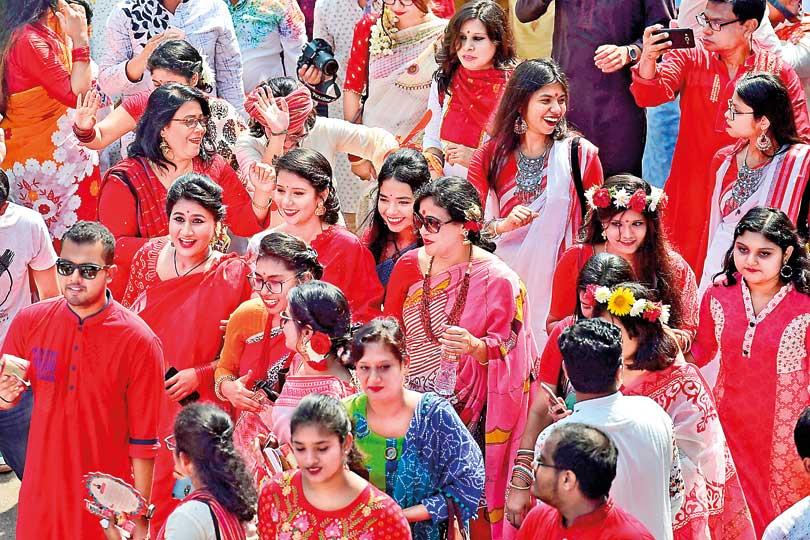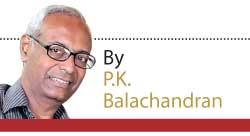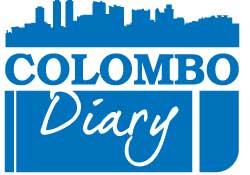17 Apr 2019 - {{hitsCtrl.values.hits}}

 Few would know that the only social and cultural festival jointly observed by Muslims and Hindus in the Indian sub-continent is the Bengali New Year in Bangladesh.
Few would know that the only social and cultural festival jointly observed by Muslims and Hindus in the Indian sub-continent is the Bengali New Year in Bangladesh.
Here, one is not talking about national events like the Independence Day or the Republic Day in which participation cuts across social, religious and ethnic communities, but to a traditional cultural festival which has a Hindu undertone.
The Bengali New Year called Pohela Boishakh falls on April 14 as does the New Year for the Tamils and the Sinhalese in Sri Lanka. The festivities connected with it are marked by a mix of the secular and the religious. They broadly fall under the rubric of “indigenous culture.”
In Bangladesh, PohelaBoishak physically brings together both the Hindus and the Muslims in joint celebrations which highlights the fact that while they may be following Hinduism or Islam in their private lives, they are all basically “Bengalis”, an ethnic group with its own distinct language, culture and history.
The joint celebration of PohelaBoishak is a clear rejection of the pernicious pre-1947 “Two Nation” theory according to which Muslims and Hindus are two different “nations” which cannot live in one united “nation state.”
On April 14, it was a riot of colour at the Dhaka University and its environs which were the venues of the mass celebration. Women in gorgeous Dhakai cotton saris and Tangail silk saris, decked in fancy jewellery and flowers in their hair, accompanied by menfolk in colourful kurtas and pajamas poured into the scene of festivities from all corners of Dhaka in their thousands.
Even the most orthodox Muslim women in the crowd, were in colourful chadors and abayas, befitting the joyous occasion. Many women in an Abaya and chador were wearing a wreath of flowers around their heads
Perhaps influenced by the Buddhist Chakma tribes of the Chittagong hills, many women were wearing a wreath of red and white flowers on their heads. Roses and jasmine seemed to predominate.
The majority of those in such colourful attire were Muslims, who seemed indistinguishable from the Hindus with the women sporting a red mark on their forehead called Bindi which is characteristic of Hindu women. Even the most orthodox Muslim women in the crowd, were in colourful chadors and abayas, befitting the joyous occasion. Many women in an Abaya and chador were wearing a wreath of flowers around their heads. The only thing the orthodox Muslim women avoided was the bindi which marks Hindu women from others. But the majority of Muslim women were in saris and sported the bindi.The majority of the saris were in crimson and cream considered auspicious by Hindu Bengali.
The festivities began with a large chorus of women and men dressed in the auspicious cream and crimson, singing poet Rabindranath Tagore’s songs including “Amar Shonar Bangla” which is also Bangladesh’s national anthem.
This was followed by Mangal Shobhajatra (which can be roughly translated as Auspicious and Beautiful Procession or Journey) a colourful procession of giant art works made in clay depicting birds, animals and human faces. The stylized and giant portrayals done in typical Bengali style, delighted the young and old alike.
 Organized by the students of Dhaka University’s Institute of Fine Arts, the MangalaShobhajatra procession wended through the streets surrounding the university. Young men in the procession would break into song and dance as young boys and girls played the traditional Bengali drum called the dhol.
Organized by the students of Dhaka University’s Institute of Fine Arts, the MangalaShobhajatra procession wended through the streets surrounding the university. Young men in the procession would break into song and dance as young boys and girls played the traditional Bengali drum called the dhol.
Groups of colourfully clad girls, with a small tray of paint and a brush in their hands offered to paint “ShuboNoboBorsho” (Happy New Year) on visitors’ faces and hands. Many visitors seized the opportunity to have the new trendy “body art” done on them.
The Dhaka Metropolitan police distributed packets of traditional Bengali sweets. Bamboo fans were given to ward off the heat. Hawkers selling the traditional artifacts of rural Bengal did brisk business in the midst of the sea of humanity.
All this was done under heavy protection provided by the Dhaka Metropolitan Police whose Kalashnikov toting men were everywhere keeping a close watch on the crowd. The procession itself was accompanied by a huge platoon of police commandos on motorbikes. Government could not take chances given the Islamic fundamentalists’ denunciation of such festivities as “un-Islamic”.
The Mangal Shobhajatra is free of commercial and state patronage, even though it is held under state protection. It is funded by the teachers, students and alumni of the Faculty of Fine Arts. They raise funds by selling their artworks.
It was in 1989 that the students of Dhaka University first organized MangalShobhajatra. But its origin goes back to the days when Bangladesh was part of Pakistan as “East Pakistan”. It was the Bengali Language Movement launched by Dhaka university in 1952 which created an opening for thoughts, practices and observances which have a “Bengali” rather a Muslim or Hindu past.
Soon after the formation of a Muslim-majority Pakistan in 1947, its founder Governor-General Mohammad Ali Jinnah declared that “Urdu and Urdu alone” would be the national language of Pakistan though Bengali-speakers were 56% of Pakistan’s population at that time.
The agitation that Dhaka University students launched against this declaration snowballed and resulted in many being killed in police firing. Though the movement was quelled, the powers ensconced in West Pakistan kept marginalizing Bengali-speakers in multiple ways which over time, led to a freedom struggle which led to the formation of independent Bangladesh in 1971. The mammoth struggle claimed three million Bengali lives, both Muslim and Hindu.
The adoption of Tagore’s Amar Shonar Bangla as the new Bengali nation’s anthem and the joint celebration of Pohela Boishakh and organizing the MangalShobhajatra later, had become symbols of Bangladeshis’ identity. These symbols denoted the composite “Bengaliness” of Bangladesh and its people, without being overtly either Hindu or Muslim.
Perhaps influenced by the Buddhist Chakma tribes of the Chittagong hills, many women were wearing a wreath of red and white flowers on their heads. Roses and jasmine seemed to predominate
Interestingly, the origin of Pohela Baishakh has Hindu and Muslim elements. It was the Hindu King of Bengal, Shashanka of the Gaur (Gauda) dynasty,who introduced to Bengal the solar calendar. As per this calendar, the Bengali New Year fell in the month of Agrahayan. The idea apparently was to mark and celebrate the Aman harvest annually.
In the early Mughal or Muslim era, the solar calendar was replaced by a lunar one. Later in the Mughal era, in 1582, Akbar, the greatest of all the Mughal emperors, wanted to combine elements of Hinduism and Islam to form a new religion called Deen-e-Ilahi or the Religion of God. The idea was to unite his diverse subjects.
As part of the unification programme, Akbar initiated a reform of the calendar for more efficient tax collection. He reconciled the lunar and solar calendars making the month of Baishakh replace the month of Agrahayan as the first month of the year.
Pohela Baishakh falling on April 14 of the Gregorian calendar is the first day of the Bengali New Year. Despite the switch over to the Gregorian calendar for many purposes under British rule and thereafter, traditional Bengali businessmen continued the tradition using Akbar’s calendar in which NoboBorsho or the New Year falls on April 14.
On this day, businessmen open new account books. In villages all over Bengal, the tradition of heralding the New Year with fairs where local crafts would be sold, has stayed. Performance of the traditional jatra plays, music and dance performances, kite flying, boat races, and even wrestling, not to mention feasting, marked the festivities.
Fakrul Alam, an academic, in an article in The Daily Star says that Pohela Boishakh and the practices associate with it, have been part of rural Bengali life for ages. What one sees now is only a revival in response to emerging political circumstances.
29 Nov 2024 9 hours ago
29 Nov 2024 29 Nov 2024
29 Nov 2024 29 Nov 2024
29 Nov 2024 29 Nov 2024
29 Nov 2024 29 Nov 2024